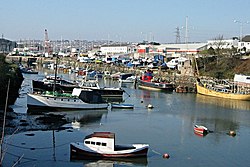Plymstock
| Plymstock | |
| Devon | |
|---|---|
 Pomphett Lake, Plymstock | |
| Location | |
| Grid reference: | SX511531 |
| Location: | 50°21’35"N, 4°5’38"W |
| Data | |
| Population: | 24,758 (2011) |
| Post town: | Plymouth |
| Local Government | |
| Council: | Plymouth |
| Parliamentary constituency: |
South West Devon |
Plymstock is a sizable town in south-western Devon, which has become in effect a commuter suburb at the western edge of the City of Plymouth.
Standing on the east bank of the River Plym, Plymstock is physically separated from Plymouth by the estuary of the Plym and the Cattewater, looking out at the city from across the waters and joined only by one viaduct and roads driven around the heads of the creeks and by ferry. It is a conglomeration of a number of villages, amongst them Billacombe, Elburton, Goosewell, Hooe, Mountbatten, Oreston, Pomphlett, Staddiscombe, Turnchapel. Plymstock proper is the centrally located village after which the parish and suburb is named.
The parish church is St Mary and All Saints.
The pedestrianised 1960s Broadway consists of a number of shops including one supermarket within the precinct with a an out-of-town store nearby, three banks, six estate agents and other local amenities including a fire station and a small police station. At Pomphlett there are more shops.
The population at the time of the 2011 census, Plymstock had a recorded population of 24,758.
Name
The earliest surviving documentary reference to the place is as Plemestocha in the Domesday Book: its name appears to be derived from Old English Plymen stocc, meaning "Outlying farm with plum-trees", or arguably a contracted version of Plymentunstocc, meaning 'Plympton Farm'. "outlying farm belonging to Plympton".[1]
The River Plym appears to be named as a backformation from Plymstock and Plympton, not the other way round.
Transport links
The local branch railways through the area to Turnchapel and Yealmpton have been removed, the bridges and stations demolished and the land built on. Pomphlett Mill has been demolished and the site used for a roundabout. Pomphlett Creek (shown right), once a popular rowing stretch has been partly filled in and what remains is largely silted up.
Frequent buses connect most areas of Plymstock with routes across the city linking with the railway station and Derriford hospital. There is a water-taxi linking Mountbatten with Plymouth Barbican.
History
Until the 20th century Plymstock was a rural parish but began to develop rapidly just before and after the Second World War as a residential area outside Plymouth but acting as a dormitory area for the city. On 1 April 1967,[2] Plymstock, along with Plympton, was absorbed into the civic jurisdiction of the City of Plymouth. Today it forms a populous and mostly home-owning south-eastern suburb of the city.
About the town
There are numerous public spaces including a huge public sports area at Staddiscombe. There is a major golf club at Staddon Heights and a commercial driving range near Elburton. Strident campaigning to get permission and funding for a local public swimming pool have so far failed. Rowing is available on the River Plym, there is a sailing club at Oreston and a large water-sports centre at Turnchapel. There are public tennis courts at Dean Cross.
Folklore
Childe's Tomb on Dartmoor is the legendary site of the death of Childe who, caught in a snowstorm, killed and disembowelled his horse and climbed inside for shelter, but still froze to death. He left a message to say that the first person to bury him would get his lands at Plymstock. The avaricious monks of Tavistock buried him and claimed the lands. The ghosts of monks carrying a bier have supposedly been seen at Childe's Tomb.[3]
References
- ↑ Watts, Victor (2010). The Cambridge Dictionary of English Place-names (1st paperback ed.). Cambridge University Press. p. 476. ISBN 978-0-521-16855-7.
- ↑ Moseley, Brian (February 2012). "Plymstock". Plymouth Data. Archived from the original on 26 September 2013. https://web.archive.org/web/20130926163440/http://www.plymouthdata.info/Plymstock.htm. Retrieved 14 February 2015.
- ↑ Hippisley Coxe, Anthony E. (1973). Haunted Britain. Pub. Hutchinson. ISBN 0-09-116540-7. p. 30.